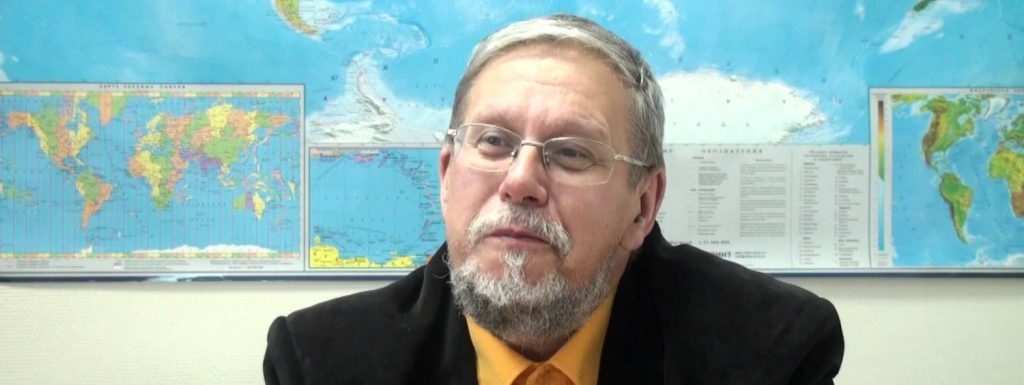Sergei Borisovich Pereslegin is the director of Knowledge Economics Center at the International Scientific-Research Institute for Management Problems, scientific director of “Knowledge reactor” project group and a specialist in the field of future forecasting and modeling (psycho history).
Today we are talking with Sergey Pereslegin on the subject of the Sixth (VI) techno-economic paradigm:
How can you characterize the emerging VI techno-economic paradigm?
The emerging VI techno-economic paradigm can be called the transindustrial paradigm. It is characterized by robots, that is, the domination of artificial intelligence in production, and additive manufacturing. We can already say that within the VI paradigm there are two engineering approaches: (XI) modern robots and (XII) robots programmed in natural languages. The last approach presumes the joint training of human and robots, and the creation of man-machine communities.
This techno-economic paradigm perfectly serves the concepts of “globalization”, “world market” and “Bologna process”, that is, it occupies a service position, unlike other techno-economic paradigms that were in a controlling position in relation to all other manifestations of civilization.
The VI paradigm “formula” is «robotics + additive manufacturing », robotics presumes the wide usage of robots-AIS (Artificial Intelligence Systems) in production and management processes, in transportation, and finally in education and cognition. The robots are not essentially androids. Transport AIS are not only and not so much automated (unmanned) control systems for cars, trains or pipelines, rather they are primarily drones – unmanned aerial vehicles with a wide range of purposes, including military.
Each technological paradigm is characterized by its own organization that is tribal, neighboring, ethnic, national, and global. The generic features of the VI paradigm are closed production cycles.
In essence, this is a transition from the nature destruction, which was characteristic of industrial production and nature conservation in the V “ecological” paradigm model, to the nature rational usage. Such a transition may not be of a crisis nature, however we must remember that environmental economics conflict with the interests of numerous “greens”, and, moreover, requires very serious changes not only in legislation, but also in economic theory and insurance models.
We can assume something about a VII paradigm to follow. As far as can be judged, these are AIS that no longer meet the Turing test requirements, but the Lem criterion, that is, they are capable of creative activity, creating not only new, but also totally different. VII paradigm means post-technologies and man-machine communities.
The economy digitization and the production robotization are characterized by the emergence of new and the disappearance of old professions, as well as the related unemployment. What can you say about this?
It makes sense to talk about two versions of such unemployment now.
At first Chinese created “silly robots”. The position of a Tianxia (celestial) engineers is that “the robot-driver must have an intelligence of a horse rather than human”. “Silly robots” are simple, fault-free. They do not make mistakes. They do not get tired, do not lose concentration, or spoil the equipment. They have already begun the process of displacing unskilled labor from production.
Secondly, there are “smart robots”, European, American, Korean, and, to a certain extent, Japanese. These robots and, primarily, their software are sophisticated and expensive, but they can do nearly everything.
Today they dance, sing, write articles and philosophical treatises, lecture and manage finances. And again, they have plenty of advantages over highly qualified specialists: they do not get tired, they do not make mistakes, they do not take bribes and they comply with all the requirements of the law and regulatory legal acts. “Smart robots” replaced people in the legal service of Sberbank in Russia. Who will prevent them from replacing of Sberbanks’ CEO Mr. Gref?
The next important paradigm feature is the wide use of additive technologies. This term is well established, but misleading. “Additive”, meaning also “appending”, “growing” technologies that represented and still are the basis of agriculture, including mariculture. If we talk about the production means manufacturing, then this is, for example, the crystals growth as a component basis of micro- and nanoelectronics.
The transition from 3D printing to quantum copying is inevitable in the logic of prediction. We are talking here about the hologram concept generalization. A hologram reproduces the optical properties of an object. We should also talk about how to reproduce its other properties – hardness, elasticity, electromagnetic field, etc. To do this we have to learn to copy the structure of an object at the atomic level. It is likely that such a copier can be made using a microwave generator of coherent radiation that is a gamma laser with a wavelength order of hundredths of nanometer.
Not to mention the fact that such a laser is a powerful weapon, the creation of copiers reproducing the atomic structure of an object creates a number of serious problems, starting at least with the collapse of the entire market of precious stones, antiques, old masters paintings…
These problems can be associated, in a highly simplified form, with copyright because copiers will replicate material objects, just as modern computers replicate texts, audio and video files with a single command. This will lead to social upheaval as even if the copiers will not copy people, it is not entirely clear what can prevent them.
It may seem that a quantum copier is a very, very distant future, “fiction”. However, firstly, either additive technologies will reach this level, or we simply will not need them, and, secondly, “copiers” annoyingly appear in the prognostic analysis of the physics of mesoscopic media, mechanochemistry, probe microscope; it looks like an attractor of natural development of nanotechnology and we already covered much of the journey to it.
How globalization and global world order crisis link together?
Post-industrialism caused globalization. The V technological paradigm decline turned into the global world order crisis. This crisis was caused by the world complexity and heterogeneity, the growth of both monetary and non-monetary (terrorism, anthropogenic) globalization costs. It emerged as a sanctions regime, calling into question the two global economy cornerstones, the global division of labour, that is the opportunity to buy what is not made in a given territory, and confidence in the international banking system, which means the confidence in the safety of funds withdrawn beyond national jurisdiction.
It is clear that the VI paradigm does not imply the return of the world to the state preceding globalization, which is the era of nation states. Today there is reason to talk about the “post-global projects competition”, among which there are four main versions.
First of all, globalization is a transition from a single global world order to a multi-local world, divided into segments with its “protectors”, its currencies, its markets. Globalization is the design of macro-regions, and there is the planning to develop separate “rules of the game” for each such macro-region. It seems to be a very difficult management task to find a balance in which macro-regions will be big enough, but not immensely complex and diverse.
Further, there are e-colonialism and e-economy, the “ecological approach” and the division of countries into ecological rent recipients and payers. As far as we can judge, the European Union is the only one interested in such a version of the post-global world. Neither the USA, nor China, nor Russia is going to follow it and since the EU does not have the ability to impose its ideas about a post-global world with force, we can hardly expect the concept of ecological globalization implemented in practice.
Infrastructure capitalism presupposes a combination of sovereign national states and supranational, “world”, “global” infrastructures, including modern (Internet, global communications, global navigation, global information, data center) and advanced ones. This approach has been developed quite carefully, its advantage is a good interface with the emerging formats of VI paradigm organization.
How do you predict the postglobal world development?
Cosmocolonialism, cosmopolitics, cosmoeconomics, cosmoculture … “Post-globalism” appears here in its most powerful form: post-global is “out of our planet”.
Globalization takes advantage of the scale of the planet.
It is impossible to solve world problems at the Earth level; you need to go to the next level, which is space. It is unlikely that we can fold this marginal version of the post-global world, but at least Elon Musk developed its significant media potential.
When discussing options for post-globalization, it is necessary to take into account that a relatively smooth transition from the nation-states world to the post-global world was accomplished by dismantling the USSR and Eastern Europe; in other words, the cold war losers “paid for” this transition.
The transition to a post-global world will have to be paid for separately, and as far as one can judge, there is a general implicit agreement to do this at the expense of the European Union. Options are always possible, and post-globalization may turn out to be, if not a cause, a reason for a number of military conflicts.
Digitization is in full swing and it looks like this process is largely self-organizing. How do you predict this process development?
“Digit” is an important feature of the VI paradigm; here we are talking not only about the digital economy and electronic finance, but also about the “digital law” and, perhaps, the “digital science”.
The digital science means the mass unemployment among scientists, that is, individuals who, firstly, consider themselves to be the salt of the earth, and, secondly, have invested their whole lives in their education. It is also the collapse of the existing (Bologna) educational system. As for the “digital law”, there are more lawyers than there are scholars, and they, of course, are pillars of society.
But in this case it is not even the biggest problem. Already today there are situations, not only possible, but existing, like that where the parking AIS (artificial intelligence system) enters into an agreement with the car AIS without any human participation. It is clear that this type of transaction will grow like a snowball. We shall either have to apply to AIS the status of an individual, a subject of law, a person, eligible to enter into legal relations; or accept that the right loses subjectivity and should be viewed as a set of restrictions imposed on relations between objects. Both options are revolutionary and, apparently, hardly acceptable…
The VI paradigm installation will be accompanied by a transition to a new administration format that is the reflexive control. One might hope that this hedges the risks we have noted to some extent, but, as a rule, changes in the management model are of a crisis nature in themselves, and an increase in political, economic and social instability accompany them.
How are observable transients associated with a capital crisis?
The capital crisis is the most important factor determining the need to install a new production mode.
We can understand the capital according to Karl Marx, as the self-increasing value, the potential of money to produce new money. A thermodynamic approach is convenient when one considers capital as the assets free energy, the assets ability to do work on transforming the world.
The Marx formula “money – commodity – money” is a gross simplification in modern conditions. In fact, capital, being the assets free energy, transforms the world in such a way that other and necessarily larger assets are possible in the changed world.
The “money – the world – goods / services – the world – money” formula works. Therefore, capital is interested in development, where development is the process of transition from one world to another world, the modified world creation. This determines the interest of capital in creating new production means as the basis of global and macro-regional projects implementation.
Capital is also interested in a society with a low social entropy, since one can understand the social entropy as a measure of linking assets to a poorly organized society.
Low-entropic society is characterized by high diversity (high quality of life) and development through self-organization process. This contradicts the globalization logic with its desire for unification and standardization, therefore globalization leads to a capital crisis, and capital in turn seeks to destroy the globalization regime.
Thus, capital needs: development, markets, diversity, self-organization and production, rather than parasitic cycles.
The main causes of the capital crisis are as follows:
• Practical exhaustion of the free space on the planet with the impossibility of commercially efficient space exploration (except near-earth space). We are talking about the disappearance of the civilization frontier, of the civilization free surface, of external territories that are not covered by the dominant system of activities. The free space exhaustion deprives the capital of extensive development possibility through the tapping of new territories;
• modern society normative and legal overregulation, which reduces dramatically the development pace and closes a number of opportunities for the development of self-organization processes. The deceleration of development deprives capital of the possibility of intensive development through the world transformation;
• the globalization regime reduces diversity and deprives capital of development opportunities through cross-border processes;
• the fixed assets renewal slowdown, physical and moral obsolescence of the production means, primarily in the energy field, deprives the capital of development opportunities through the implementation of macro-projects. There is the problem aggravation due to the lack of “long money” in the modern global financial system capable of servicing such projects, as well as due to the catastrophic overproduction of “short money” not secured by real assets and requiring extremely fast, speculative circulation;
• the imitation activity expansion (packaging, marketing, branding, creative industry products, impressions industry, etc.) to the detriment of production activities. This leads to illusory diversity instead of meaningful and, indirectly, increases social entropy.
The capital crisis manifests itself primarily as the profit rate decline in all business types, except speculative ones, and thus leads to the investments leaching from the real sector of the economy. This process is manifested indirectly in a change of the education content, where there is a transition from the translation of knowledge and skills to the provision of educational services. The skilled personnel reproduction is disrupted gradually, including in science.
For the time being, the negative effects are suppressed by the expansion of “creative industry” and the “service economy”, reduction of costs through the active involvement of illegal migrants to work, and the absorption of the destroyed Eastern European world economies. These opportunities were exhausted by the end of the 2000s, which led to the 2008 “mortgage crisis”.
The way out of this crisis was impossible within the framework of the V techno-economic paradigm, which provoked a sharp exacerbation of the foreign policy situation in 2013–2014, the summer of 2014 “military alarm”, the “sanctions regime”, the globalization crisis and the “world consensus” on new production means.
While analyzing the situation at the “world” level, it is necessary to pay attention to the growth of contradictions at three levels of consideration at once:
• political and economical;
• between states;
• between states and corporations;
• between corporations;
• between dominant, subdominant and non-dominant
• between legislative and executive power in a crisis of judicial power
• between elites and population (“right” and “left”);
• between local people and migrants
• ontological
• cultural
• specific (between humans and “transhumanoids”, the humanity separation)
Your prediction for the future?
It is first necessary to fix a critical conceptual lag at the “country” level. The country should redefine in the new conditions: “Who am I?”, “What am I doing?”, “Where am I going (What future seems acceptable to me)?”, “Why am I?”, “What are civilizational, spiritual, cultural or, at least ideological foundations?” This conceptual lag is much more dangerous than economic and even technological lag.
Such an increase in contradictions, in the absence of reasonable techniques to work, leads to permanently high military risks, and this can be both: classic wars between large states, using all means of warfare, and proxy wars conducted through intermediaries and without direct strikes on metropolises of the conflict interested parties.
Thus, we project a series of proxy conflicts around the “instability arc”, stretching from Australasia across the East China Sea, Tibet, the Middle East, the Arabian Peninsula to South West Africa.
Interview: Ivan Stepanyan
*The interview used materials provided by RAS Institute of Economic Strategies











